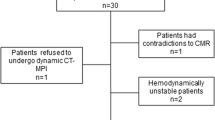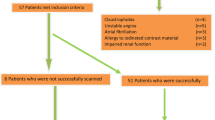Abstract
Objective
To evaluate the diagnostic accuracy of dual-source CT (DSCT) prospective ECG-triggering coronary angiography in patients with different heart rate (HR).
Methods
103 patients with suspected coronary artery disease underwent DSCT prospective ECG-triggered coronary angiography and invasive coronary angiography (ICA). The patients were grouped by HR during CT scans: low HR (≤60 bpm, n = 34); medium HR (60 < HR ≤ 70 bpm, n = 36) and high HR (>70 bpm, n = 33). The sensitivity and specificity of DSCT in detecting ≥50% stenosis were compared among subgroups where ICA was the gold standard. Image quality was scored using a 4-point scale.
Results
A total of 1,580 (95.9%) coronary artery segments were evaluable. Sensitivity and specificity were 82.8% and 98.4%, 88.3% and 98.7%, and 80.3% and 98.6% for different subgroups (all p > 0.05). The overall area under the curve of the receiver-operating characteristic analysis was 0.94. The image quality scores were 3.1 ± 0.3, 3.1 ± 0.3 and 3.0 ± 0.4 for subgroups (p > 0.05). The overall average effective radiation dose was 3.60 ± 1.60 mSv.
Conclusion
DSCT coronary angiography with prospective ECG-triggering could be just as accurate in patients with medium to high HR compared to those with low HR.



Similar content being viewed by others
References
Donald LJ, Robert JA, Todd MB et al (2010) Heart disease and stroke statistics—2010 update: a report from the American Heart Association. Circulation 121:948–954
Gaziano TA (2007) Reducing the growing burden of cardiovascular disease in the developing world. Health Aff 26:13–24
Bastarrika G, Lee YS, Huda W et al (2009) CT of coronary artery disease. Radiology 253:317–338
Einstein AJ, Henzlova MJ, Rajagopalan S (2007) Estimating risk of cancer associated with radiation exposure from 64-slice computed tomography coronary angiography. JAMA 298:317–323
Ketelsen D, Thomas C, Werner M et al (2010) Dual-source computed tomography: estimation of radiation exposure of ECG-gated and ECG-triggered coronary angiography. Eur J Radiol 73:274–279
Schoenhagen P (2008) Back to the future: coronary CT angiography using prospective ECG triggering. Eur Heart J 29:153–154
Ko SM, Kim NR, Kim DH et al (2010) Assessment of image quality and radiation dose in prospective ECG-triggered coronary CT angiography compared with retrospective ECG-gated coronary CT angiography. Int J Cardiovasc Imaging 26:93–101
Klass O, Jeltsch M, Feuerlein S et al (2009) Prospectively gated axial CT coronary angiography: preliminary experiences with a novel low-dose technique. Eur Radiol 19:829–836
Earls JP, Berman E, Urban BA et al (2008) Prospectively gated transverse coronary CT angiography versus retrospectively gated helical technique: improved image quality and reduced radiation dose. Radiology 246:742–753
Alkadhi H, Stolzmann P, Scheffel H et al (2008) Radiation dose of cardiac dual-source CT: the effect of tailoring the protocol to patient-specific parameters. Eur J Radiol 68:385–391
Pflederer T, Jakstat J, Marwan M et al (2010) Radiation exposure and image quality in staged low-dose protocols for coronary dual-source CT angiography: a randomized comparison. Eur Radiol 20:1197–1206
Hein F, Meyer T, Hadamitzky M et al (2009) Prospective ECG-triggered sequential scan protocol for coronary dual-source CT angiography: initial experience. Int J Cardiovasc Imaging 25:231–239
Scheffel H, Alkadhi H, Leschka S et al (2008) Low-dose CT coronary angiography in the step-and-shoot mode: diagnostic performance. Heart 94:1132–1137
Herzog BA, Husmann L, Burkhard N et al (2008) Accuracy of low-dose computed tomography coronary angiography using prospective electrocardiogram-triggering: first clinical experience. Eur Heart J 29:3037–3042
Achenbach S, Anders K, Kalender WA (2008) Dual-source cardiac computed tomography: image quality and dose considerations. Eur Radiol 18:1188–1198
Srichai MB, Hecht EM, Kim D et al (2009) Dual-Source computed tomography angiography image quality in patients with fast heart rates. J Cardiovasc Comput Tomogr 3:300–309
Maruyama T, Takada M, Hasuike T et al (2008) Radiation dose reduction and coronary assessability of prospective electrocardiogram-gated computed tomography coronary angiography: comparison with retrospective electrocardiogram-gated helical scan. J Am Coll Cardiol 52:1450–1455
Husmann L, Valenta I, Gaemperli O et al (2008) Feasibility of low-dose coronary CT angiography: first experience with prospective ECG-gating. Eur Heart J 29:191–197
Alkadhi H, Scheffel H, Desbiolles L et al (2008) Dual-source computed tomography coronary angiography: influence of obesity, calcium load, and heart rate on diagnostic accuracy. Eur Heart J 29:766–776
Rixe J, Rolf A, Conradi G et al (2008) Image quality on dual-source computed-tomographic coronary angiography. Eur Radiol 18:1857–1862
Rixe J, Rolf A, Conradi G et al (2009) Detection of relevant coronary artery disease using dual-source computed tomography in a high probability patient series: comparison with invasive angiography. Circ J 73:316–322
Ropers U, Ropers D, Pflederer T et al (2007) Influence of heart rate on the diagnostic accuracy of dual-source computed tomography coronary angiography. J Am Coll Cardiol 50:2393–2398
Lu B, Mao SS, Zhuang N et al (2001) Coronary artery motion during the cardiac cycle and optimal ECG triggering for coronary artery imaging. Invest Radiol 36:250–256
Lell M, Marwan M, Schepis T et al (2009) Prospectively ECG-triggered high-pitch spiral acquisition for coronary CT angiography using dual source CT: technique and initial experience. Eur Radiol 19:2576–2583
Xu Y, Tang LJ, Zhu XM et al (2010) Comparison of dual-source CT coronary angiography and conventional coronary angiography for detecting coronary artery disease. Int J Cardiovasc Imaging 26:75–81
Herzog BA, Wyss CA, Husmann L et al (2009) First head-to-head comparison of effective radiation dose from low-dose 64-slice CT with prospective ECG-triggering versus invasive coronary angiography. Heart 95:1656–1661
Acknowledgement
This study was granted by the Ministry of Science and Technology of China, Grant NO. 2007BAI05B02.
Author information
Authors and Affiliations
Corresponding author
Rights and permissions
About this article
Cite this article
Sun, Ml., Lu, B., Wu, Rz. et al. Diagnostic accuracy of dual-source CT coronary angiography with prospective ECG-triggering on different heart rate patients. Eur Radiol 21, 1635–1642 (2011). https://doi.org/10.1007/s00330-011-2107-5
Received:
Revised:
Accepted:
Published:
Issue Date:
DOI: https://doi.org/10.1007/s00330-011-2107-5




